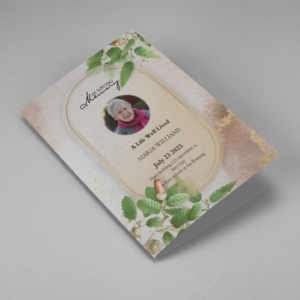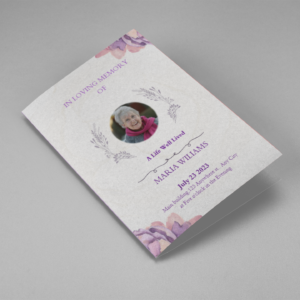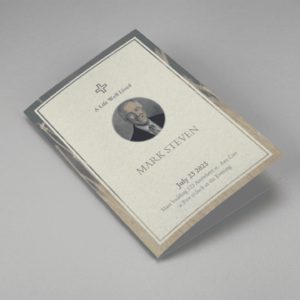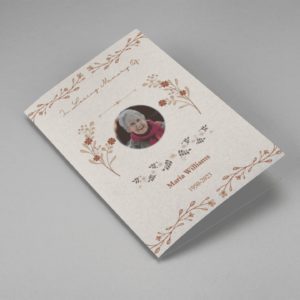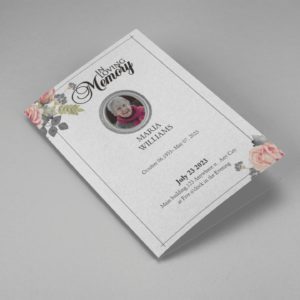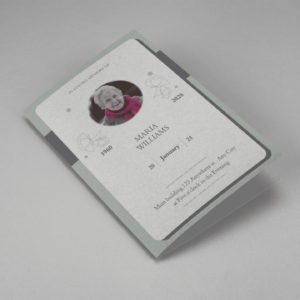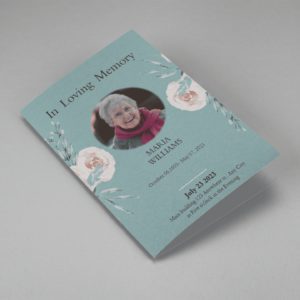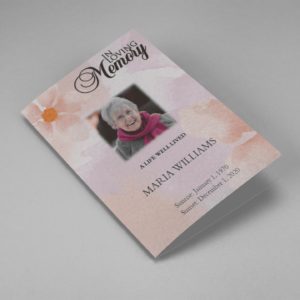Losing a loved one is one of life’s most challenging experiences, and during this time, it’s important to have a way to honor their memory and express condolences. Visitation cards play a crucial role in funeral services and memorial events, providing a way for attendees to leave heartfelt messages, share their support, and sign in as guests. These cards serve as keepsakes for the bereaved family, offering comfort in knowing who attended the visitation or service.
What Are Visitation Cards?
A visitation card is a small printed card used during a funeral, wake, or memorial service. It allows guests to record their names, share condolences, or offer personal messages to the grieving family. These cards can be collected in a guest book or kept as a separate memento.
Visitation cards are commonly used in:
- Funeral Homes & Memorial Services – Guests can sign in and leave their names for the family.
- Church Services & Wakes – To record attendance and offer prayers or support messages.
- Graveside Services – Visitors can leave a note in memory of the deceased.
Why Are Visitation Cards Important?
1. Keeps a Record of Attendees
During a funeral or visitation, many guests come to pay their respects. A visitation card helps families remember who attended and who offered their support, making it easier to send thank-you notes later.
2. Personal Messages of Sympathy
These cards allow guests to write heartfelt messages, prayers, or fond memories, providing comfort to the bereaved family.
3. A Cherished Keepsake
For many families, visitation cards become treasured mementos that they can look back on to remember the kindness and support they received during their time of loss.
4. Helpful for Future Memorials
Some families use visitation cards to create a memorial book or keepsake album, ensuring the memory of their loved one lives on.
Types of Visitation Cards
1. Traditional Guestbook Style Cards
These are small cards where guests write their names and a brief message. They are typically placed in a basket or near a guestbook for collection.
2. Personalized Visitation Cards
Families can customize visitation cards with a photo of the deceased, a short obituary, or a meaningful quote. This makes them more personal and heartfelt.
3. Religious Visitation Cards
For faith-based funerals, religious visitation cards often feature Bible verses, prayers, or spiritual quotes, offering comfort to guests and the grieving family.
4. Folded Visitation Cards
Some visitation cards are designed as folded keepsakes, providing more space for messages and allowing guests to write longer condolences.
5. Memorial Bookmark Visitation Cards
A unique option, these cards double as a memorial bookmark. They typically feature a picture, name, birth and death dates, and an inspirational quote or poem.
How to Choose the Right Visitation Card
Selecting the right visitation card depends on several factors, including the type of service and the preferences of the bereaved family. Here are some key considerations:
1. Style and Design
- Choose a design that reflects the personality of the deceased.
- Consider using soft, muted colors for a traditional look or vibrant colors for a celebration-of-life event.
2. Customization Options
- Look for templates that allow for personalization, such as adding photos, quotes, or prayers.
- Some online services offer editable templates for quick and easy customization.
3. Paper Quality
- Use high-quality cardstock for a more durable keepsake.
- Glossy or matte finishes add a professional touch.
4. Size and Format
- Standard sizes include 3”x5” or 4”x6” cards for easy handling.
- Folded designs or bookmarks can provide extra space for messages.
How to Create Personalized Visitation Cards
If you prefer to design your own visitation cards, follow these steps to create a meaningful and professional-looking keepsake.
1. Choose a Template
Start with a visitation card template that fits the tone of the service. Many websites offer free and premium templates that are easy to customize.
2. Add Personal Details
Include important details such as:
- The name of the deceased
- Birth and death dates
- A short obituary or meaningful message
- A poem, quote, or religious verse
3. Select High-Quality Images
If adding a photo, ensure it is a high-resolution image for the best print quality.
4. Pick a Font and Color Scheme
- Use classic fonts like Times New Roman or Garamond for a traditional look.
- Soft, neutral colors like white, beige, or pastels work well for funeral settings.
5. Print and Prepare the Cards
- Print on high-quality paper or cardstock for durability.
- Consider professional printing services for a polished result.
- Have a designated area at the service for guests to fill out the cards.
Funeral Templates
-
Searching for a Oak Leaf With Gold Oval Frame Half Page Funeral Program that is easy to print and amass and has a cutting-edge look? The Oak Leaf With Gold Oval Frame Half Page Funeral Program is the Perfect decision because it measures 8.5”x 5.5”.
- No Limitation on Content, Edit anything
- Edit anytime – unlimited revisions even after purchased
- Get a printable PDF downloaded to get it printed on your own.
-
Searching for a Brown and White Classic Funeral Program Half Page Program that is easy to print and amass and has a cutting-edge look? The Brown and White Classic Funeral Program Half Page Program is the Perfect decision because it measures 8.5”x 5.5”.
- No Limitation on Content, Edit anything
- Edit anytime – unlimited revisions even after purchased
- Get a printable PDF downloaded to get it printed on your own.
-
Searching for a Purple Elegant Watercolor Half Page Funeral Program Template that is easy to print and amass and has a cutting-edge look? The Purple Elegant Watercolor Half Page Funeral Program Template is the Perfect decision because it measures 8.5”x 5.5”.
- No Limitation on Content, Edit anything
- Edit anytime – unlimited revisions even after purchased
- Get a printable PDF downloaded to get it printed on your own.
-
Searching for a Cream and Green Photo Obituary Half Page Program that is easy to print and amass and has a cutting-edge look? The Cream and Green Photo Obituary Half Page Program is the Perfect decision because it measures 8.5”x 5.5”.
- No Limitation on Content, Edit anything
- Edit anytime – unlimited revisions even after purchased
- Get a printable PDF downloaded to get it printed on your own.
-
Searching for a Cream Simple Elegant Photo Church Half Page Program that is easy to print and amass and has a cutting-edge look? The Cream Simple Elegant Photo Church Half Page Program is the Perfect decision because it measures 8.5”x 5.5”.
- No Limitation on Content, Edit anything
- Edit anytime – unlimited revisions even after purchased
- Get a printable PDF downloaded to get it printed on your own.
-
Searching for a Samovar Silver Half Page Funeral Program Template that is easy to print and amass and has a cutting-edge look? The Samovar Silver Half Page Funeral Program Template is the Perfect decision because it measures 8.5”x 5.5”.
- No Limitation on Content, Edit anything
- Edit anytime – unlimited revisions even after purchased
- Get a printable PDF downloaded to get it printed on your own.
-
Searching for an Elegant Beige Half Page Funeral Program Template that is easy to print and amass and has a cutting-edge look? The Elegant Beige Half-Page Funeral Program Template is the Perfect decision because it measures 8.5”x 5.5”.
- No Limitation on Content, Edit anything
- Edit anytime – unlimited revisions even after purchased
- Get a printable PDF downloaded to get it printed on your own.
-
Searching for a White Floral Pro Half Page Funeral Program Template that is easy to print and amass and has a cutting-edge look? White Floral Pro Half Page Funeral Program Template is the Perfect decision because it measures 8.5”x 5.5”.
- No Limitation on Content, Edit anything
- Edit anytime – unlimited revisions even after purchased
- Get a printable PDF downloaded to get it printed on your own.
-
Searching for a Grey and Burgundy Elegant Half Page Funeral Program Template that is easy to print and amass and has a cutting-edge look? Grey and Burgundy Elegant Half Page Funeral Program Template is the Perfect decision because it measures 8.5”x 5.5”.
- No Limitation on Content, Edit anything
- Edit anytime – unlimited revisions even after purchased
- Get a printable PDF downloaded to get it printed on your own.
-
Searching for a Soft Green and Grey Minimalist Floral Half Page Funeral Program Template that is easy to print and amass and has a cutting-edge look? Soft Green and Grey Minimalist Floral Half Page Funeral Program Template is the Perfect decision because it measures 8.5”x 5.5”.
- No Limitation on Content, Edit anything
- Edit anytime – unlimited revisions even after purchased
- Get a printable PDF downloaded to get it printed on your own.
-
Searching for a Gray Elegant Oval Frame Half Page Funeral Program Template that is easy to print and amass and has a cutting-edge look? Gray Elegant Oval Frame Half Page Funeral Program Template is the Perfect decision because it measures 8.5”x 5.5”.
- No Limitation on Content, Edit anything
- Edit anytime – unlimited revisions even after purchased
- Get a printable PDF downloaded to get it printed on your own.
-
Searching for a Blue Organic Minimal Half Page Funeral Program Template that is easy to print and amass and has a cutting-edge look? Blue Organic Minimal Half Page Funeral Program Template is the Perfect decision because it measures 8.5”x 5.5”.
- No Limitation on Content, Edit anything
- Edit anytime – unlimited revisions even after purchased
- Get a printable PDF downloaded to get it printed on your own.
-
Searching for a Pink and Orange Watercolour Half Page Funeral Program Template that is easy to print and amass and has a cutting-edge look? Pink and Orange Watercolour Half Page Funeral Program Template is the Perfect decision because it measures 8.5”x 5.5”.
- No Limitation on Content, Edit anything
- Edit anytime – unlimited revisions even after purchased
- Get a printable PDF downloaded to get it printed on your own.
-
Searching for a Pink Floral Paper Half Page Funeral Program Template that is easy to print and amass and has a cutting-edge look? Pink Floral Paper Half Page Funeral Program Template is the Perfect decision because it measures 8.5”x 5.5”.
- No Limitation on Content, Edit anything
- Edit anytime – unlimited revisions even after purchased
- Get a printable PDF downloaded to get it printed on your own.
Funeral Programs : Helping Videos
Frequently Asked Question On Visitation Cards
What is the purpose of visitation cards?
Visitation cards are used during funerals or memorial services to record the names of attendees and allow guests to leave personal messages of sympathy.
Are visitation cards necessary for a funeral?
While not required, they are a thoughtful addition to any funeral or memorial service, helping families keep track of visitors and their messages of support.
What should I write on a visitation card?
Guests typically write their names, a brief message of condolence, and sometimes a memory of the deceased.
Where can I buy visitation cards?
Quickfuneral is the best place for this.


